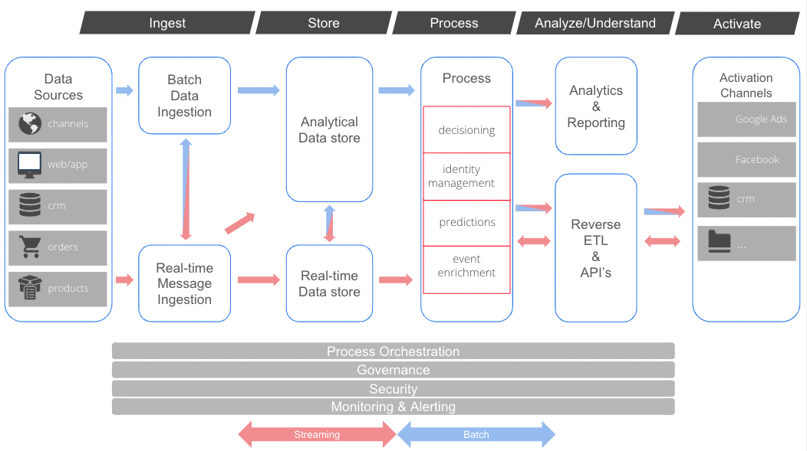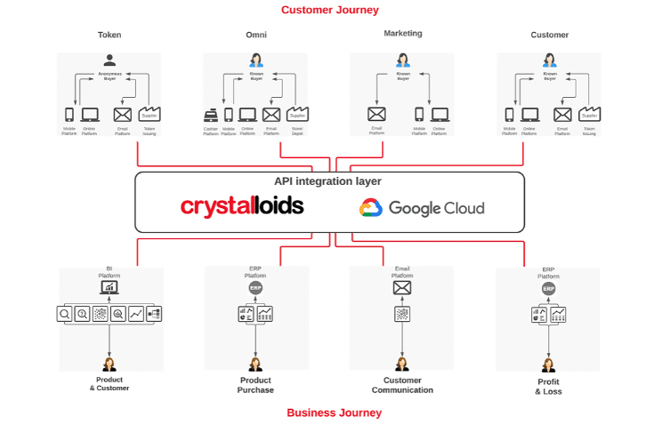Share this
Part 2: Packaged vs Headless CDP: Which one is right for you?
by Marc de Haas & Jan Hendrik Fleury on Mar 15, 2023 9:47:01 AM

Customer Data Platforms (CDPs) have become an essential tool for businesses looking to optimize their marketing strategies and improve customer experiences. In the first blog series, we introduced the packaged and headless CDP and pointed out some limitations of the traditional solutions.
In this second blog series, we’ll dwell deeper into the differences between packaged and headless CDP. We'll explore the benefits and drawbacks of each option, and we'll discuss which solution might be better suited for your business.
The headless CDP approach vs. CDP tools: functionality comparison
In contrast to headless CDP, the packaged CDPs usually specialize in different areas. Some platforms prioritize activation, personalization, and AI, while others focus on generating insights, identity resolution, and a comprehensive 360° view of the customer. Despite their differences, nearly all of these systems require the collection and ingestion of source data. Typically, this involves implementing additional on-site trackers using Javascript, as well as uploading first-party data to combine online data with order or CRM data.
.jpg?width=1405&height=704&name=Free%20technology%20choice%20(2).jpg)
When talking about a packaged and a headless CDP when a cloud data warehouse environment is already present, the following comes up:
- The data sources that already flow into your data warehouse, also have to be integrated with the CDP.
- Capturing and collecting real-time behavioral data is most of the time already implemented by systems such as Google Analytics or Snowplow. So why, in the case of a packaged CDP, would you add another tracker on your website/app that potentially slows down your website and which measurement methodology certainly will differ from the measurement you are already familiar with?
- Duplicating business rules already present in your warehouse environment, such as identity resolution, creation of a 360 customer view or audience selections.
If the above applies to your organization, there will be overlap. Most packaged CDP and data management tools do not work together in such a way that they can use on everything that is already collected and calculated in your data warehouse.
Disadvantages of a headless CDP
Stand-alone CDPs also have their advantages. First off all, if you don't have a data warehouse (yet) and/or resources are limited, a packaged CDP suite could fit your needs and get you started quickly, seeing the out-of-the box functionality. The cost factor heavily depends on the type of system, volume and integrations. When zooming in, the headless CDP has the following disadvantages:
- No central user interface & ease of use: a headless system does not have an integrated user interface where settings can be easily adjusted or insights can be given into all processes. It is certainly possible to gain insight into the processes of a headless system, but those insights have to be created yourself or are available in multiple systems. There might be technical / SQL knowledge required to set up audiences or journeys for example. An option is to put a low code application on top such as Google’s Appsheet or using Looker Blocks and Actions.
- (Real-time) decision engine / flow builder: making decisions based on real-time data flows (e.g. web or app data). Creating such a real-time decision engine (e.g. online personalization use cases) within the cloud is possible, but is more complex than clicking rules together in a user interface because that is code based. Also, creating flows / journeys is easily done within most CDP solutions. Often we use Google’s Cloud Composer for batch orchestration. For real-time we use a Cloud Function and PubSub.
- Connectivity to channels and tools is maintained by the platform. In a headless CDP, you have to build a part of the integrations yourself (mostly through API connections), although there are currently several (open-source) frameworks available, such as Google Tentacles and "reverse ETL" tools such as Looker, Hightouch, Flywheel Software, Census.
- The time-to-market is longer because the platform has to be designed and built.
If your organization is not complex, if the use cases you are looking for are basic and if you don’t want to hire a services company like Crystalloids, then a packaged CDP is a good fit. However, be aware that if a packaged CDP fits your existing requirements, there is a great chance that there will have limitations when your maturity grows.
Reverse ETL
There are already a lot of tools that ingest data into your warehouse. More recently, a new segment has entered the market: reverse ETL. These tools can activate data to your marketing channels or other platforms. Reverse ETL tries to solve this problem. A reverse ETL tool enables you to focus on building use cases and not to worry about connector development and maintenance (e.g. Flywheel Software, Census, Hightouch, Looker Actions, Segment). Next to that, the tools are providing insights in the process and data that flows out of your cloud platform.
An example setup:
Next to using Google Cloud-native tools, also third party ISV SAAS point solutions can be used for ingestion, transformation, analysis or governance. If you do so, you get a hybrid composed CDP. Crystalloids helps you in determining what works best for you.
When to choose a headless CDP approach?
When your organization already has a cloud data warehouse or planning to set one up, the headless approach is interesting if you:
- Don't want to purchase and implement an (expensive) CDP tool, for example if you want to share audiences, triggers or other data directly from the data warehouse with your (marketing) channels or (external) platforms.
- Want to realize advanced and more complex use cases based on different sources and combinations, which are not possible or hard to achieve in packaged/stand alone CDP tools (by clicking stuff together) or without moving the data out and in the CDP platform to perform the necessary actions.
- Do not want to duplicate data and recreate business rules in different environments (single source of truth).
- Want to optimally leverage existing investments in a cloud data warehouse. Even if your data lake resides on a non-Google Cloud, Google Cloud still remains the most suitable option for hosting your CDP.
- Unlock the potential of and activate non-customer data, such as product or campaign data.
- If you want to reduce vendor lock-in of systems and applications.
- If the cost of the packaged CDP grows 10X while your business grows 2X. A headless approach cost only increases with additional processing and storage needed to handle the growth. Until now we’ve seen headless being more cost effective.
- Using various cloud services and dedicated / specialized tools (such as reverse ETL), it's possible to connect data and tools relatively easily, bringing flexibility of choice.
- If you want to enjoy flexibility in on- and offboarding point solutions in the future. Which you will because nothing stays the same for always.
Why Integrating GCP Can Enhance Your Existing non-Google Data Lake Infrastructure?
What if your business already has a datalake on AWS, Azure or another cloud environment? It’s understandable that you want to safeguard your investments in these clouds and don’t want to replicate.
In such cases, we don’t build another datalake. We only bring the data to the CDP on Google Cloud that is needed for the marketing and sales use cases and link the results back to the datalake and other systems. Adopting a multi-cloud strategy is a trend where companies pick the best cloud for their use cases.
GCP offers seamless integration with various data sources, enabling you to unify your data and access it easily from a single location. This can save you valuable time and resources that would have otherwise been spent on managing disparate data sources. So, while safeguarding your investments in existing clouds is important, it's worth considering the benefits of integrating GCP to unlock the full potential of your data.
Google Cloud is very well positioned for headless CDP for several reasons:
- the native connectors with advertising platforms
- the AI capabilities that are nicely tuned for marketing and advertising
Next to that, we adopt a serverless platform meaning that no technical maintenance is required.
Realtime headless CDP applied by Crystalloids
The data flows and integrations that we have developed leveraging the cost effective and real-time capabilities of the Google Cloud Platform, are pre-defined building blocks that can be tailored to your specific requirements. Instead of packaged software, where you depend on the existing functionalities and roadmap of the supplier, we build a solution that will always meet your present and future demands. Therefore our headless CDP (API driven) Data Platform offers more flexibility to define your own rules regarding aspects such as user stitching or building audience segments.

The advantages of a headless CDP
More Flexibility
By using a modular, loosely coupled architecture and persisting data in a real-time cloud data warehouse, the headless CDP approach provides the flexibility necessary to quickly innovate and have an agile roadmap.
Reduced Vendor Lock-In
Unlike pre-built CDP options, data is not "locked" into the headless CDP approach. The "single-source-of-truth" is available for all applications, reducing the risk of vendor lock-in.
Real-Time Loop-Back
The headless CDP approach also allows for an easy and real-time loop-back to source systems that require consolidated data from the CDP.
Cost Efficiency
The use of cloud-native components with a pay-as-you-go pricing model makes the headless CDP approach cost-effective with low total cost of ownership.
.jpg?width=1581&height=702&name=Free%20technology%20choice%20(1).jpg)
Conclusion: What approach fits your situation?
If you're looking to take your customer data strategy to the next level, a headless CDP may be just what you need. With its flexible architecture, cloud-native design, and robust data management capabilities, a headless CDP can help you unlock the full value of your customer data and stay ahead of the competition in today's fast-paced digital world.
As a result of our long-year experience and focus, Crystalloids offers end-to-end services. So why wait? Start exploring our headless CDP options today and see how it can transform your business for the better.
You might also be interested in these articles:
- PART1: Packaged vs Headless CDP: Which one is right for you?
- 10 Benefits of a Customer Data Platform (CDP)
ABOUT CRYSTALLOIDS
Crystalloids connects IT and business with scalable and flexible solutions. As a Premier Google Cloud Partner, Crystalloids is a specialist in end-to-end data management, including BI, data science and activation. Using transparent, agile development, Crystalloids ensures that use cases deliver immediate value and that our customers are in complete control.
Share this
- July 2024 (2)
- June 2024 (2)
- May 2024 (1)
- April 2024 (4)
- March 2024 (2)
- February 2024 (2)
- January 2024 (4)
- December 2023 (1)
- November 2023 (4)
- October 2023 (4)
- September 2023 (4)
- June 2023 (2)
- May 2023 (2)
- April 2023 (1)
- March 2023 (2)
- January 2023 (4)
- December 2022 (3)
- November 2022 (5)
- October 2022 (3)
- July 2022 (1)
- May 2022 (2)
- April 2022 (2)
- March 2022 (5)
- February 2022 (3)
- January 2022 (5)
- December 2021 (5)
- November 2021 (4)
- October 2021 (2)
- September 2021 (2)
- August 2021 (3)
- July 2021 (4)
- May 2021 (2)
- April 2021 (2)
- March 2021 (1)
- February 2021 (2)
- January 2021 (1)
- December 2020 (1)
- October 2020 (2)
- September 2020 (1)
- August 2020 (2)
- July 2020 (2)
- June 2020 (1)
- March 2020 (2)
- February 2020 (1)
- January 2020 (1)
- December 2019 (1)
- November 2019 (3)
- October 2019 (2)
- September 2019 (3)
- August 2019 (2)
- July 2019 (3)
- June 2019 (5)
- May 2019 (2)
- April 2019 (4)
- March 2019 (2)
- February 2019 (2)
- January 2019 (4)
- December 2018 (2)
- November 2018 (2)
- October 2018 (1)
- September 2018 (2)
- August 2018 (3)
- July 2018 (3)
- May 2018 (2)
- April 2018 (5)
- March 2018 (5)
- February 2018 (2)
- January 2018 (4)
- November 2017 (2)
- October 2017 (2)



No Comments Yet
Let us know what you think